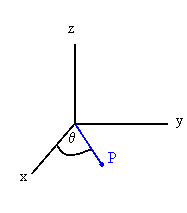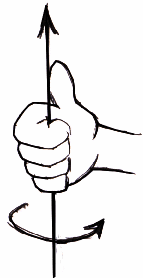 |
Angles can be measured in units of degrees or radians. 360 degrees = 2π radians. When describing rotational motion it is most convenient to measure angles in units of radians. To find out how fast the wheel is rotating, we measure its angular speed ω. The average angular speed is given by
Every point on the wheel has the same angular speed. The units of angular speed are rad/s or s-1, because radians are not dimensional |
|
Assume that you turn the axle of the spinning wheel from vertical to horizontal. The wheel is still spinning with the same angular speed, but its angular velocity ω has changed. Angular velocity is a has magnitude and direction. Its magnitude is the angular speed, and its direction is the direction of the axis of rotation. There is, however, a subtlety we have to take care of. Assume that the axis of rotation is vertical. What is the sense of rotation? Is the wheel spinning clockwise or counterclockwise as viewed from above? Just saying the axis is vertical does not tell us the sense of rotation. To specify the sense of rotation we use a convention called the right-hand rule. If the fingers of your right hand are curling to indicate which way the wheel is turning, then the thumb of you right hand is pointing in the direction of the axis of rotation. This is the direction of the angular velocity.
|
